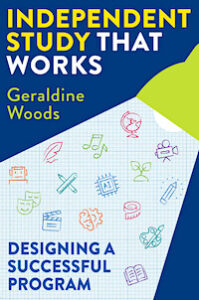Designing Successful Independent Study
Independent Study That Works: Designing a Successful Program
By Geraldine Woods
(W.W. Norton & Company, 2022 – Learn more)
Reviewed by Sarah Cooper

Woods begins with her own experience, running a yearlong, full-credit elective independent study class at a private high school in New York, and then branches out to apply to anyone’s situation.

The “bedrock” features of Woods’ independent study programs are, in her words:
- Student power and responsibility
- Adult guidance
- Flexibility
- Performance
Ideally, the “performance” element takes the form of a seminar-style presentation by each student to the class once per grading period, in which they teach the class about their project. This structure has multiple benefits: giving students practice in public speaking, keeping them accountable, and helping them see what they’ve accomplished and where they need to go.
Woods’ pre-presentation questions for the students illustrate the depth and practicality that characterize this book. Every chapter contains not just big goals but also immediate ways to implement them.
● What do you want the class to learn?
● Which concepts are most important?
● What teaching method makes sense?
● Will you need any special equipment or materials?
● How will you divide up the time?
● Will you assign your fellow students homework?
● How will you acknowledge sources?
Later in the book, Woods suggests additional ways for students to share their knowledge, including seminar presentations with guests, an independent study festival, and visits to other classes. This kind of public audience can deepen student engagement and also lead to impact much later in life.
According to Gresa, a former student reflecting back on her experience: “You have to succinctly put together an explanation of what you have done and what you will do next…. That skill set is transferable. I use it now in conferences with my manager.”
What’s in the book
The book’s chapters scaffold nicely, starting with skills and process, such as writing a proposal, and leading up to broader ideas, such as how projects can connect with the community:
Introduction: Education as It Was Meant to Be
1. The Independent Study Program
2. The Project
3. The Seminar
4. Adaptations
5. Subject Area Tips
6. Independent Study as a Homeschooling Option
7. Independent Study Units Within a Traditional Class
8. Beyond the Classroom
Appendix A: Using Common Core Standards to Evaluate Projects
Appendix B: Sample Forms
Woods peppers the book with sample project ideas for various disciplines, such as exploring linguistics for someone interested in world languages or doing engineering projects in STEAM subjects. It also includes plenty of suggestions to entice other teachers or community members into being mentors for projects about which they are passionate.
Ultimately, the beauty of Independent Study That Works is that it invites readers to join the author at whatever point works for their school and their program. For teachers and administrators interested in bringing any of these ideas to your classroom or school, I strongly encourage reading the whole book, only 134 pages. It offers so many ideas that you won’t know which apply best to your teaching until you come across them yourself – a quality of the best independent study research!
In this MiddleWeb article
Geraldine Woods focuses on
Independent Study for Middle Schoolers.
Sarah Cooper teaches eighth-grade U.S. history and is Associate Head of School at Flintridge Prep in La Canada, California, where she has also taught English Language Arts. Sarah is the author of Making History Mine (Stenhouse, 2009) and Creating Citizens: Teaching Civics and Current Events in the History Classroom (Routledge, 2017). She presents at conferences and writes for a variety of educational sites. You can find all of Sarah’s writing at sarahjcooper.com.




























